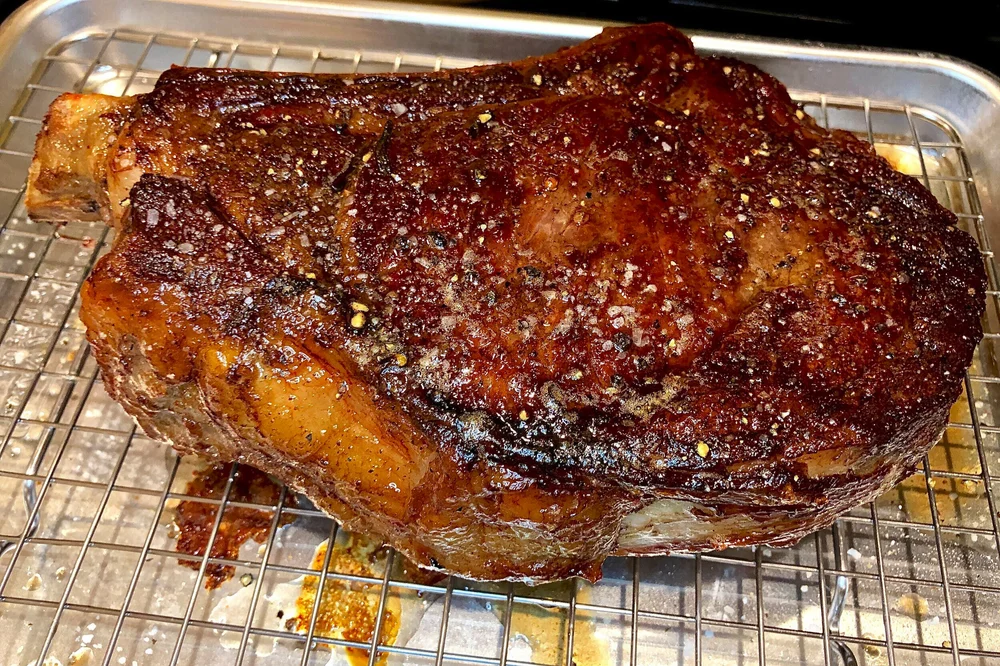
I must confess, the Hubs and I were in somewhat of a steak rut when he approached me one weekend, with a recipe in hand and a question. We have a longstanding tradition of cooking steaks on Sunday (#SundaySteaks) and he had just read about a technique called the “reverse sear” that he really wanted to try. As the primary steak maker in the house, I thought, “sure, let him challenge my methods and further reinforce how amazing my mad steak skills are,” and I relinquished my beloved cast iron skillet for the evening.
And WOW am I glad I did! The reverse-seared steak was utterly delicious, not to mention, stunningly beautiful!
We’ve been happily experimenting with the “reverse sear” method ever since and it is currently our preferred method of making steak. Unlike some other cooking methods that have gained popularity in recent years, this one is straightforward, user friendly and doesn’t require any expensive, specialized equipment - a major #petpeeve! All you need are kitchen essentials like a good cast iron skillet, meat thermometer, quarter sheet pan with a rack, and, of course, the steak itself. More on that later.
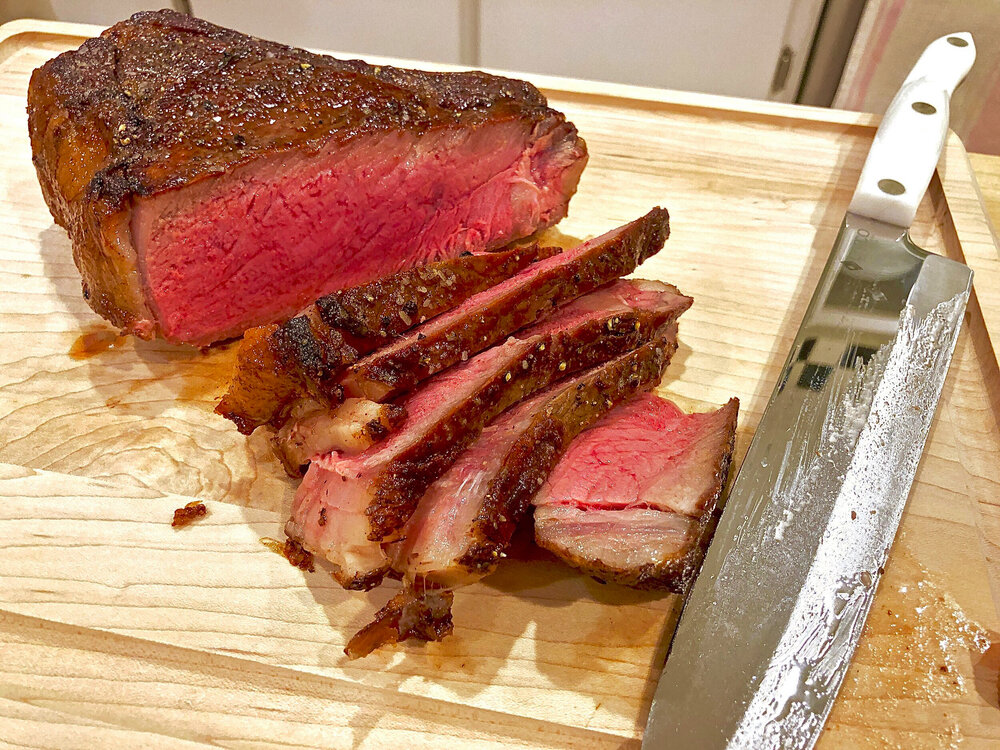
The “reverse sear” technique is exactly that, reversing the two main components of cooking a steak. Normally, a steak is first seared in a screaming hot pan on both sides before it is then finished in the oven to the desired level of doneness. The “reverse sear” on the other hand calls for the steak to first be roasted at a low temperature in the oven to the desired level of “doneness”, and then finished in the pan to form that mandatory, glorious, outer crust.
Sounds easy enough, right? That’s because it is! Here are some reasons why you should definitely try the “reverse sear”:
No expensive cooking equipment or excessive amount of time are required.
Cooking the steak at a low, slow temperature allows the steak to cook slowly and evenly.
For best results, use a thicker, bigger cut of meat which practically guarantees leftovers!
By roasting the steak BEFORE searing it, you have more control over the cooking process.
You can add your favorite herbs to the butter during the finishing, searing process which infuses the steak with incredible flavor.
As for the steak, we recently discovered Wild Fork Foods, an emporium of over 500 different types of meat ranging from chicken to alligator tail. All of their meat is flash frozen at the peak of freshness to lock in all if its amazing flavor. For the reverse sear method, it’s best to use a thicker cut of meat, and a bone-in option is even better. We love their Bone-in Black Angus Beef Florentine Steak, an impressive, 2-1/2 inch thick cut steak that’s inspired by one of our favorite Tuscan steaks of all time, Bistecca alla Fiorentina.
This Florentine classic is essentially a bone-in Porterhouse steak that is gloriously marbled, has delightfully complex flavors and a luxurious, buttery texture. Other cuts that work well with the reverse sear (and again the thicker the better), include the ribeye, NY strip, T-bone, tri-tip and filet mignon.
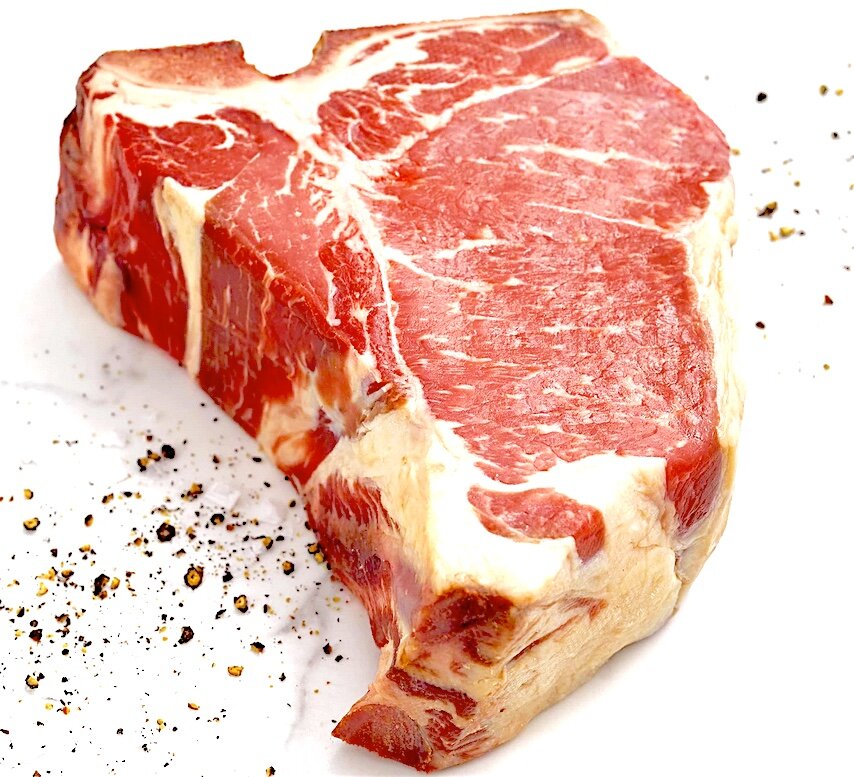
Your meat thermometer is going to be a key factor in determining when the steak is done cooking in the oven, especially in the beginning. For rare, shoot for an internal temperature of 110 degrees; for medium-rare (our favorite!), the internal temperature should be 120 degrees; for medium, the internal temperature should be 130 degrees; for medium-well, the internal temperature should be 140 degrees; and for well-done, well you should be arrested if you would do that to a beautiful piece of meat like this so please DON’T and shoot for a temperature below 140 degrees!!!
So finally, as promised, here are 5 Simple Steps to Mastering the “Reverse Sear” Technique:
1.) Preheat your oven to 300 degrees, the low temperature allows the steak to cook slowly and evenly. We also allow the steak to come to room temperature for about 30 minutes before going in the oven.
2.) To prepare the steak, pat it dry with paper towels to remove any moisture and season it generously on both sides with Kosher salt and freshly ground black pepper. Place the steak on the rack in the sheet pan and slide it into the preheated oven. For the majestic, 3-1/2 lb. Florentine steak, it usually takes about 35-40 minutes to achieve the desired internal temperature. But, depending on the cut of meat you chose (remember, bone-in cuts will take longer), be sure to have your handy meat thermometer on hand to guide you.
3.) In the meantime, prep your cast iron or other heavy skillet by adding a super thin layer of neutral oil (i.e. grapeseed, vegetable) to it and placing it on a burner over high heat.
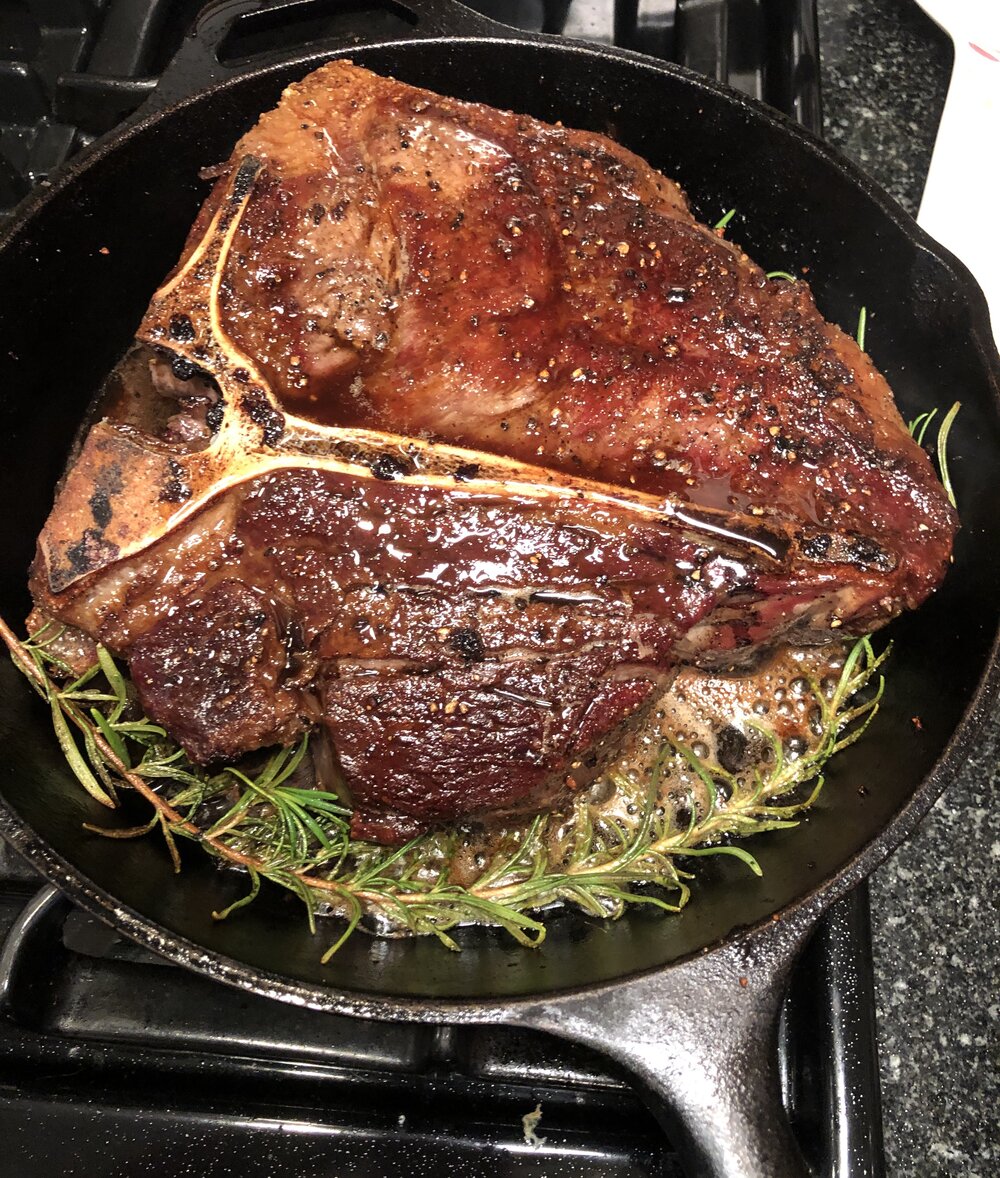
4.) Remove the steak from the oven when it’s cooked to the desired doneness, and transfer it to the screaming hot skillet (it should be smoking, it’s so hot!). Sear it on each side (it won’t take very long!) until it forms a gorgeous, golden brown outer crust, even using your tongs to bring the fat cap and other smaller sides of the meat into contact with the hot skillet - the more color, the more flavor. Once the steak is sufficiently crusted, quickly turn off the burner and remove the skillet from the heat. Immediately add a few Tablespoons of butter to the pan (it will melt instantly) and any desired herbs (we love a couple hearty springs of fresh rosemary) spoon the melted butter over the steak until the meat is coated in the butter.
5.) Remove the steak to a cutting board and allow it to rest for approximately 10-15 minutes once it comes out of the pan. Then slice it up and enjoy!
Print 5 StepsAs for wine to pair with all this meaty deliciousness? This is definitely Cab country, my friend! Yes, Cabernet Sauvignon, the signature red grape of California’s Napa Valley, is the perfect match for steak of this magnitude. It’s full-body, weighty tannins, opulent texture and complex flavors are perfect for meshing with the heavenly heft, fat and flavor of this gorgeous steak.
Some of my favorite California Cabs include the DAOU Paso Robles Cabernet Sauvignon ($25), Round Pond Rutherford Napa Valley Cabernet Sauvignon ($65), Mt. Brave Cabernet Sauvignon from Mt. Veeder ($99), La Jota Howell Mountain Cabernet Sauvignon ($150) and, for a super duper splurge, Harlan Estate’s The Maiden ($275) is an excellent choice. And while you may have seen the Cabernet pairing suggestion coming, you might not expect my next one: Rosé Champagne!

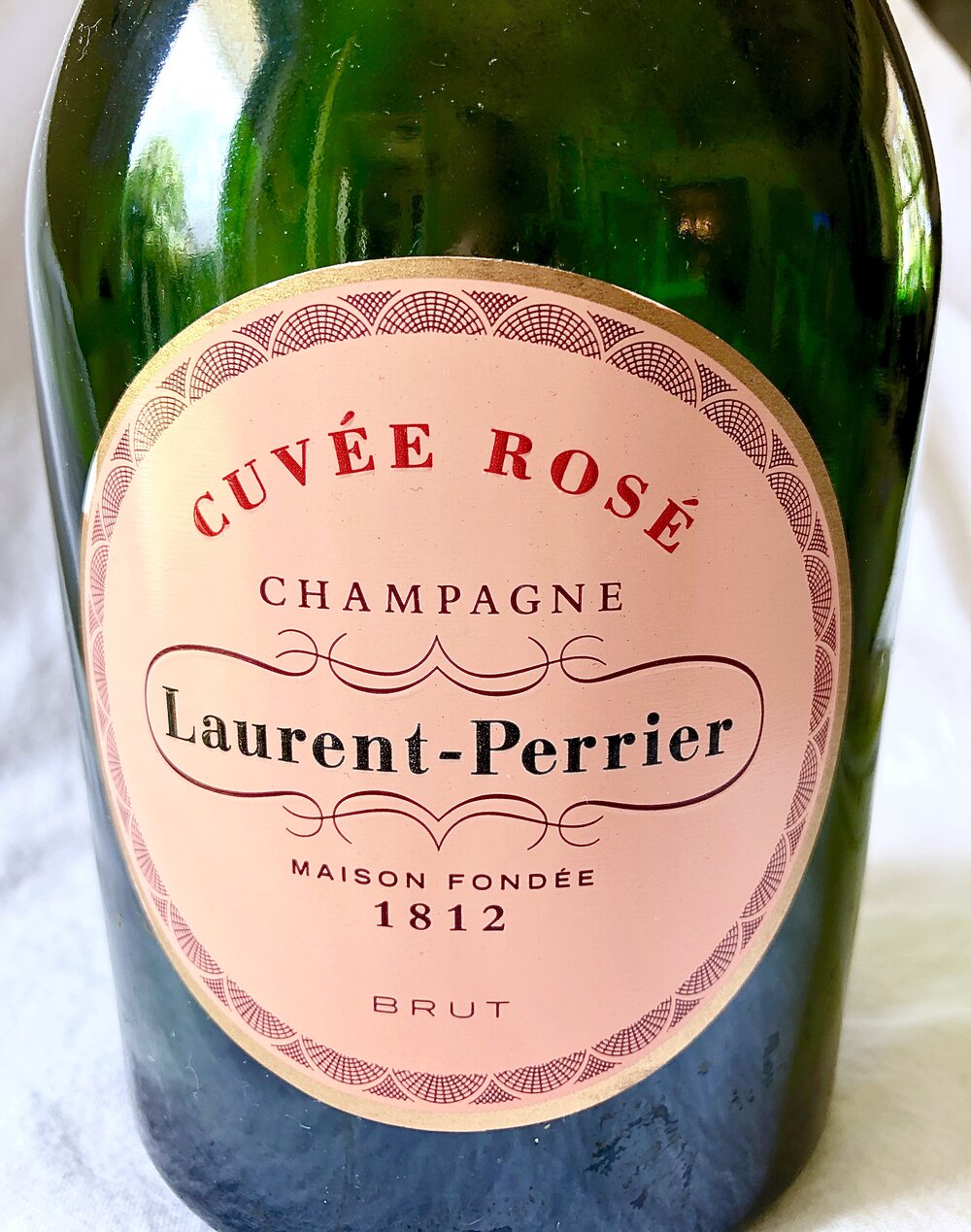
Yes, a Rosé Champagne is actually an excellent wine to pair with steak. In addition to actually containing some still red wine, which is how it gets its rosy hue, the Méthode Traditionelle (how Champagne gets its bubbles) also imparts a richness to sparkling wine that gives it tremendous texture and depth of flavor while it’s exhilarating bubbles essentially take the place of tannins. Some of my favorites include Piper-Heidsieck Rosé Sauvage ($52), Laurent Perrier Cuvée Rosé ($75) and Moët & Chandon Grand Vintage Rosé ($130).
Many thanks to the Hubs for introducing me to the deliciousness that is the “reverse sear” method! It has definitely become our preferred method of preparing steaks and I hope you enjoy it as much as we do xo
Stephanie Miskew
Author